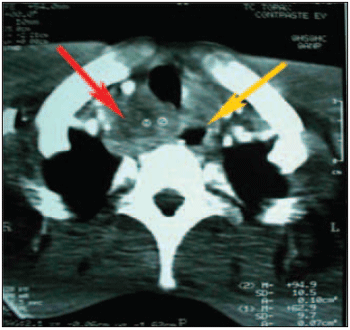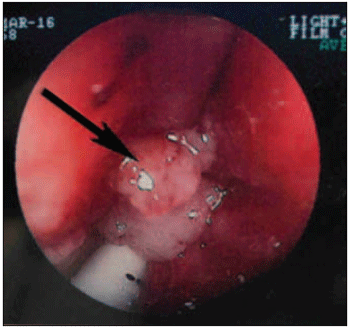INTRODUCTIONThe larynx has as mainly function to protect inferior air paths, breath, sphincteric function and phonation. All these functions are basically influenced by the mobility of the vocal folds, and, as a consequence, by the integrity of the recurrent laryngeal nerve (1). Damages to the recurrent laryngeal nerve can occur for different reasons and in its route (1).
The unilateral paralysis of vocal fold is not a rare disease and it can result from peripheral injury that involves the vagus nerve above the exit of the superior laryngeal nerve or, more distally, without its involvement, affecting only one of its laryngeal branches. Its incidence is still unknown (2).
However, bilateral paralyses of vocal folds are even rarer, especially to the ones that present with abduction (3).
The first description of bilateral paralysis of the vocal folds with adduction was by Gerhardt, in 1863, calling it "paralysis of the dilatators" of the larynx. In 1868, Ziemssem observed and described, for the first time, two patients with bilateral paralysis with abduction of the vocal folds. Later, in 1875, Riegel related conditions described by Gerhardt (3) and Ziemssen (3) as a result of paralysis of nerves and no muscular injury by syphilis as believed until then (3).
Paralyses of both vocal folds are classified in (3):
I - Global laryngeal dysfunction: absence of adduction movements and abduction, with two clinical aspects:
I.a - vocal folds in medium position - Riegel´s Syndrome;
I.b - vocal folds in intermediate position - Ziemssem´s Syndrome;
II - Paralysis of abductor muscles - Gerhardt´s Syndrome;
III - Mixed paralyses: absence of adduction movements and abduction in a vocal fold and absence only of the abductor movement in the other vocal fold.
Etiologies of bilateral paralyses with abduction of the vocal folds can be divided in congenital, traumatic, neurological and neuromuscular disorders, besides neoplasyc ones (3).
One of the tumors that can be responsible for this manifestation is the esophagus carcinoma. This neoplasm has a shady prognostic, due to its delayed diagnosis, as its symptoms arise when the disease is in an advanced period. The most common symptoms are gradual dysphagia, ponderal loss and unspecified retroesternal pain. Dysphonia is a less usual symptom, it is usually caused by unilateral vocal paralysis and it occurs when the disease is in an advanced stage (4).
The paralysis of vocal folds with abduction is extremely rare as consequence to the esophagus carcinoma, even more for being one of the responsible manifestations for the diagnosis of this tumor, as it follows.
CASE REPORTJT, 38 years, SP, construction builder.
A smoker, alcoholic patient reported dysphonia, chokes when swallowing any type of food for approximately 2 months, and also having losing 10 kg in that period. The ENT physical exam did not show alterations regarding otoscopy or on exam of oral and nasal cavities, with no touchable lymph nodes in cervical area. Regarding telescopy of the larynx, bilateral paralysis with abduction of vocal folds was noticed.
The patient was hospitalized after nasogastric probing. CT of thorax and High Digestive Endoscopy (HDE) (Picture 1) with biopsy.

Picture 1. HDE picture. Bilateral paralysis of vocal folds with abduction.
CT of thorax (Picture 2) demonstrated high mediastinal lymphadenopathy with displacement and stenosis of the adjacent esophagus light. Regarding HDE (Picture 3) it could be noticed stenosing neoplasm 20cm from the superior dental arches with biopsy which showed to be epidermoid carcinoma different from the esophagus one.

Picture 2. Thorax CT, axial cut. High mediastinal lymphadenopathy (red arrow) with displacement of esophagus light. (yellow arrow).

Picture 3. HDE picture. Stenosing neoplasm (arrow) in esophagus.
As the tumor was not surgery-recommended, patient was submitted to Chemo and Radiotherapy, under the care of the Department of Thorax Surgery.
DISCUSSIONThe paralysis of the vagus nerve and/or its branch, the recurrent laryngeal nerve can cause important morbidity due to loss of some laryngeal functions (5).
The vagus nerve is a mixed cranial one, visceral, that arises from the bulb, emerging from its posterior lateral groove. In its long journey, the nerve produces innumerable branches that stimulate larynx and pharynx (2).
One of its branches is the recurrent laryngeal nerve, which is responsible for the mobility of the vocal folds, and differs regarding the origin and journey in the two sides from the body. The right recurrent laryngeal nerve arises opposite to the first part of the subclavian artery. The left recurrent laryngeal nerve arises under the aortic arch. Both nerves go upwards the groove or next to it between trachea and the esophagus (2).
The paralyses of vocal folds can occur by injury in any part of the vagus nerve journey and its branches previously mentioned (1).
Due to the existence of asymptomatic patients, the incidence of paralyses of vocal folds from 30 to 50%, according to Collazo-Clavell (6), can be underestimated. So, its accurate incidence is still considered unknown (1).
Unilateral paralyses of the vocal folds are not rare, they occur more frequently on the left side, due to the fact that the left recurrent laryngeal nerve is more exposed to injuries for its longer journey (2).
Bilateral paralyses of vocal folds are less common and more serious, they can be of many forms, as demonstrated on classification in the introduction (3).
The paralysis of vocal folds in intermediate position, called Ziemssen´s Syndrome is the rarest of the bilateral paralyses (3). Arrais and cols (3), analyzed 17 cases of patients with paralyses of bilateral vocal folds, and only 1 of them presented Ziemssen´s Syndrome with traumatic etiology (3).
Ziemssen´s Syndrome is does not occur as dyspnea, which is difficulty in coughing. The voice is accelerated, generally with loss of it. Deglutition is painful due to the easiness how food penetrates the inferior air paths. Regarding indirect laryngoscopy, it can be noticed vocal folds in intermediate position, immovable to breath and to phonation. The glottic gap is greater than 6 millimeters (3).
Etiologies of the paralyses from both vocal folds are in large number, and sequelae from thyroid gland surgery predominates (3). Tumor diseases of the cervical and mediastinum areas are less common etiologies (3).
The esophagus cancer is one of the tumors that can cause paralyses of vocal folds. This neoplasy is one of the most frequent malignant tumors of the human body, and the epidermoid carcinoma corresponds to the most frequent histological type, occurring around 90% of the cases. Its more important risk factors are tabagism and alcoholism, antecedents verified in the patient of the reported case.
The most common symptoms are dysphagia, initially for solid and then for liquid food, ponderal loss and retroesternal pain badly defined. Hoarseness is a less common symptom, but not rare. However, dysphonia is usually caused by unilateral paralysis of vocal fold, due to compression of the recurrent laryngeal nerve.
The bilateral paralysis with adduction of the vocal folds is extremely rare, resulting from esophagus cancer. This manifestation occurs in advanced stages of the tumor (7).
In this case, Ziemssen´s Syndrome presented as the main responsible for the diagnosis of esophagus cancer of the patient. The esophagus tumor presented in advanced stage, and surgery is not recommended.
CONCLUSIONDespite this case is extremely uncommon, it is compulsory the performance of the exams from thorax image in the investigations of patients with paralysis of the vocal folds.
REFERENCES1. Myssiorek D. Recurrent laryngeal nerve paralysis: anatomy and etiology. Otolaryngol Clin N Am 2004;37:25-44.
2. Brasil, OOC do, Biase N, Behlau M, Melo, ECM. Paralsias Laríngeas. In: Sociedade Brasileira de Otorrinolaringologia. Tratado de Otorrinolaringologia, 1a edição, São Paulo, Editora Roca; 2003, vol 4, pp.477-493.
3. Arrais A, Pontes PAL, Gregório LC, Novaes RMO. Paralisia bilateral das cordas vocais: Patogenia e Diagnóstico. Acta AWHO 1986, 5(4):178-184.
4. Crosby TD et al. Definitive chemoradiation in patients with inoperable oesophageal carcinoma. Br J Câncer 2004, 90(1):70-5.
5. Steffen N, Steffen LM, Garcia DC. Paralisia unilateral de prega vocal: Ainda se usa Teflon?. Técnicas em Otorrinolaringologia 2005, 23(2):24-31.
6. Collazo-Clavell ML, Gharib H, Maragos NE. Relationship between vocal cord paralysis and benign thyroid disease. Head Neck 1995, 17:24-30.
7. Strauss A, Pinder M, Lipman J, Conidaris M. Acute stridor as a presentation of bilateral abductor vocal cord paralysis. Anaesthesia 1996, 51(11):1046-8.
1. Resident Doctor at Hospital e Maternidade Celso Pierro - Faculdade de Medicina da PUC - Campinas.
2. ENT Doctor (former resident doctor at ENT Service Department - UMCP - PUC-Campinas)
3. Resident Doctor
4. ENT Doctor (Assistant at ENT Service at Hosital e Maternidade Celso Pierro - Faculdade de Medicina da PUC - Campinas.
5. ENT Doctor (Assistant at ENT Service at Hospital e Maternidade Celso Pierro - Faculdade de Medicina da PUC - Campinas.
6. PhD and teacher of the Discipline: Thoracic Surgery at Hospital e Maternidade Celso Pierro - Faculdade de Medicina da PUC - Campinas.
7. PhD and teacher of the Discipline: Otorhinolaryngology at FMUSP; Titular Professor of Otorhinolaryngology at Faculdade de Medicina da PUC Campinas.
ENT Service of Hospital e Maternidade Celso Pierro da Faculdade de Medicina da PUC Campinas
Bruno B. Duarte - Serviço de Otorrinolaringologia do Hospital e Maternidade Celso Pierro da Faculdade de Medicina da PUC Campinas
Address: Av. Jonh Boyd Dunlop, s/n Jd Paulicéia.Campinas - SP Cep: 13060-904 - Email: brunobduarte@hotmail.com - fax number: 3729 8518
This article was submitted to SGP - Sistema de Gestão de Publicações (Publication Management System) from RAIO on April 4, 2006 and was approved on October 1, 2006, 22:30:22.